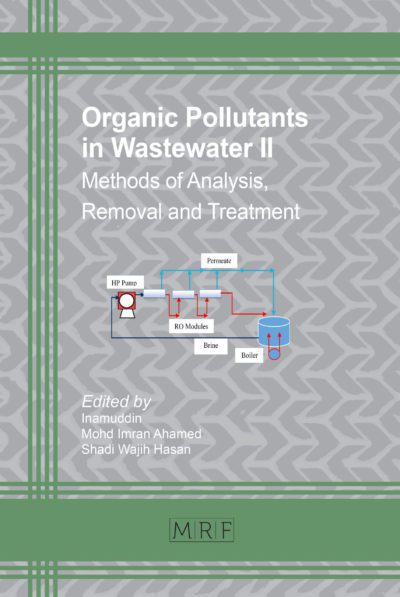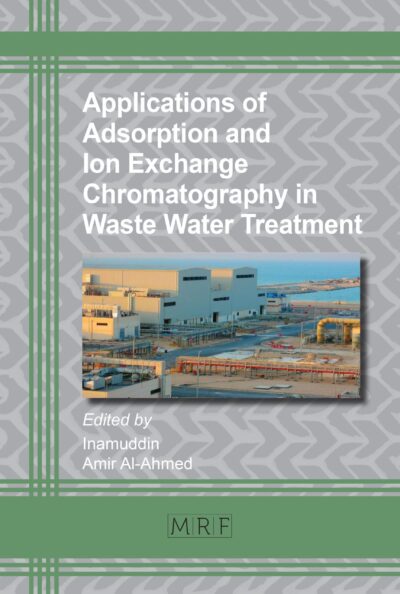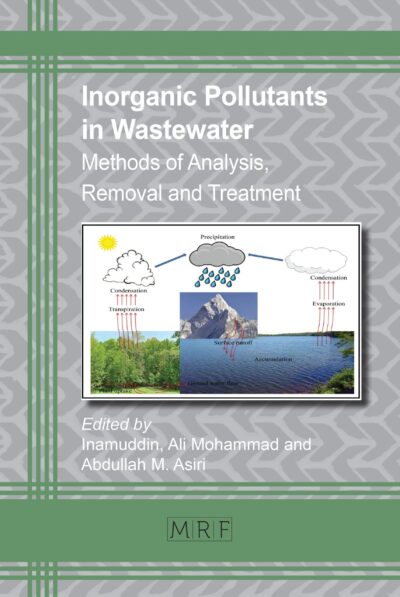Lithium recovery from aqueous solution through adsorption using batch study
AL-DHAWİ Baker Nasser Saleh, MOHAMED KUTTY Shamsul Rahman, JAGABA Ahmad Husaini, ALMAHBASHİ Najib Mohammed Yahya, AL-YAARİ Abdullah
Abstract. Treating lithium in aqueous solutions through adsorption is crucial due to the rising demand for lithium in batteries and renewable energy. This method offers a cost-effective and efficient way to capture lithium ions. Effective treatment methods are essential to mitigating these environmental risks. To address this concern, separation technologies like adsorption have been utilized to remove lithium from solutions with minimal concentrations. This study specifically investigates the removal of residual lithium from a synthesized solution using aluminum hydroxide Al(OH)3 as the adsorbent. The research examines the impact of adsorbent dosage, lithium concentration, and pH on residual lithium removal. Results underscore the substantial influence of pH on residual lithium efficiency, with optimal removal observed at pH 4.5, an adsorbent dosage of 1150 mg/L, and a lithium concentration of 1150 mg/L, achieving an 89% removal rate. The utilization of Al(OH)3for lithium adsorption has been demonstrated as an efficient technique for for recovering lithium from synthesis solutions. The process followed a pseudo-first-order kinetic model (R² = 0.917) and fit the Langmuir isotherm model (R² = 0.91). These findings contribute to a better understanding of Al(OH)3 adsorption behavior and provide perspectives on the most favorable operational parameters for effective lithium recovery.
Keywords
Lithium, Batch Study, Adsorption, Kinetic, Isotherm
Published online 4/25/2025, 7 pages
Copyright © 2025 by the author(s)
Published under license by Materials Research Forum LLC., Millersville PA, USA
Citation: AL-DHAWİ Baker Nasser Saleh, MOHAMED KUTTY Shamsul Rahman, JAGABA Ahmad Husaini, ALMAHBASHİ Najib Mohammed Yahya, AL-YAARİ Abdullah, Lithium recovery from aqueous solution through adsorption using batch study, Materials Research Proceedings, Vol. 53, pp 74-80, 2025
DOI: https://doi.org/10.21741/9781644903575-6
The article was published as article 6 of the book Decarbonization Technology
![]() Content from this work may be used under the terms of the Creative Commons Attribution 3.0 license. Any further distribution of this work must maintain attribution to the author(s) and the title of the work, journal citation and DOI.
Content from this work may be used under the terms of the Creative Commons Attribution 3.0 license. Any further distribution of this work must maintain attribution to the author(s) and the title of the work, journal citation and DOI.
References
[1] B. N. S. Al-dhawi et al., “Lithium adsorption from aqueous solution using aluminum hydroxide: Characterization, optimization by response surface methodology, kinetic modelling, and isotherm studies,” Case Studies in Chemical and Environmental Engineering, vol. 7, p. 100350, 2023. https://doi.org/10.1016/j.cscee.2023.100350
[2] A. H. Birniwa et al., “Membrane technologies for heavy metals removal from water and wastewater: A mini review,” Case Studies in Chemical and Environmental Engineering, p. 100538, 2023. https://doi.org/10.1016/j.cscee.2023.100538
[3] N. M. Almahbashi, S. R. Kutty, A. Jagaba, A. Al-nini, B. Al-Dhawi, and U. Rathnayake, “Phenol removal from aqueous solutions using rice stalk-derived activated carbon: Equilibrium, kinetics, and thermodynamics study,” Case Studies in Chemical and Environmental Engineering, vol. 8, p. 100471, 2023. https://doi.org/10.1016/j.cscee.2023.100471
[4] A.-B. A. Al-Mekhlafi, A. S. N. Isha, A. N. Al-Tahitah, A. F. Kineber, B. N. S. Al-Dhawi, and M. Ajmal, “Modelling the impact of driver work environment on driving performance among oil and gas heavy vehicles: SEM-PLS,” Safety, vol. 9, no. 3, p. 48, 2023. https://doi.org/10.3390/safety9030048
[5] Y. Boroumand and A. Razmjou, “Adsorption-type aluminium-based direct lithium extraction: The effect of heat, salinity and lithium content,” Desalination, p. 117406, 2024. https://doi.org/10.1016/j.desal.2024.117406
[6] J. Farahbakhsh et al., “Direct lithium extraction: A new paradigm for lithium production and resource utilization,” Desalination, p. 117249, 2023. https://doi.org/10.1016/j.desal.2023.117249
[7] A. Al-Yaari et al., “The effects of nanofluid thermophysical properties on enhanced oil recovery in a heterogenous porous media,” Case Studies in Chemical and Environmental Engineering, vol. 9, p. 100556, 2024. https://doi.org/10.1016/j.cscee.2023.100556
[8] I. J. J. o. t. A. C. s. Langmuir, “The adsorption of gases on plane surfaces of glass, mica and platinum,” Journal of the American Chemical society, vol. 40, no. 9, pp. 1361-1403, 1918. https://doi.org/10.1021/ja02242a004
[9] S. K. J. S. V. H. Lagergren, “About the theory of so-called adsorption of soluble substances,” Sven. Vetenskapsakad. Handingarl, vol. 24, pp. 1-39, 1898.
[10] B. N. S. Al-dhawi et al., “Phosphorus Removal from Synthetic Wastewater by Using Palm Oil Clinker as Media in Continuous Activated Sludge,” in Sustainability Challenges and Delivering Practical Engineering Solutions: Resources, Materials, Energy, and Buildings: Springer, 2023, pp. 41-44. https://doi.org/10.1007/978-3-031-26580-8_8
[11] P. Akbari Ziarani and A. Molaei Dehkordi, “Lithium Extraction from an Aqueous Medium through In Situ Synthesis of Aluminum Hydroxide: A Comprehensive Study on Adsorption and Desorption Processes, Kinetics, Isotherm Models, and Thermodynamic Parameters,” Industrial & Engineering Chemistry Research, vol. 63, no. 1, pp. 445-458, 2023. https://doi.org/10.1021/acs.iecr.3c03069
[12] A. H. Jagaba et al., “Trend and current practices of coagulation-based hybrid systems for pulp and paper mill effluent treatment: mechanisms, optimization techniques and performance evaluation,” Journal of Cleaner Production, p. 139543, 2023. https://doi.org/10.1016/j.jclepro.2023.139543
[13] B. N. S. Al-dhawi et al., “Boron adsorption from aqueous solutions through column study: desorption mechanisms, regeneration techniques, and kinetic insights,” Desalination and Water Treatment, p. 100586, 2024. https://doi.org/10.1016/j.dwt.2024.100586
[14] B. N. S. Al-Dhawi et al., “Treatment of synthetic wastewater by using submerged attached growth media in continuous activated sludge reactor system,” International Journal of Sustainable Building Technology and Urban Development, vol. 13, no. 1, pp. 2-10, 2022.
[15] L. Tian, W. Ma, and M. Han, “Adsorption behavior of Li+ onto nano-lithium ion sieve from hybrid magnesium/lithium manganese oxide,” Chemical Engineering Journal, vol. 156, no. 1, pp. 134-140, 2010. https://doi.org/10.1016/j.cej.2009.10.008
[16] A. H. Jagaba et al., “Toxicity of carbon nanotubes in wastewater treatment,” in Water Treatment Using Engineered Carbon Nanotubes: Elsevier, 2024, pp. 365-411. https://doi.org/10.1016/B978-0-443-18524-3.00004-0
[17] A. Kumar, H. Fukuda, T. A. Hatton, and J. H. Lienhard, “Lithium recovery from oil and gas produced water: a need for a growing energy industry,” ACS Energy Letters, vol. 4, no. 6, pp. 1471-1474, 2019. https://doi.org/10.1021/acsenergylett.9b00779
[18] B. N. S. Al-dhawi et al., “Optimal parameters for boron recovery in a batch adsorption study: synthesis, characterization, regeneration, kinetics, and isotherm studies,” Case Studies in Chemical and Environmental Engineering, vol. 8, p. 100508, 2023. https://doi.org/10.1016/j.cscee.2023.100508
[19] B. N. S. Al-dhawi et al., “Boron removal from produce water through adsorption,” in BIO Web of Conferences, 2023, vol. 73: EDP Sciences, p. 02002. https://doi.org/10.1051/bioconf/20237302002
[20] K. VİCKY et al., “Kinetics study of nutrients removal from synthetic wastewater using media as submerged in continuous activated sludge system,” Materials Research Foundations, vol. 29, 2022. https://doi.org/10.21741/9781644902516-12
[21] B. N. S. Al-dhawi et al., “Adsorptive removal of boron by DIAION™ CRB05: characterization, kinetics, isotherm, and optimization by response surface methodology,” Processes, vol. 11, no. 2, p. 453, 2023. https://doi.org/10.3390/pr11020453
[22] N. Al-mahbashi, S. R. Kutty, A. Jagaba, A. Al-Nini, B. Al-dhawi, and A. Noor, “Preparation of Rice Paddy Stalks-Based Activated Carbon to Remove Phenol from Aqueous Solutions,” in International Conference on Dam Safety Management and Engineering, 2023: Springer, pp. 675-685. https://doi.org/10.1007/978-981-99-3708-0_46














